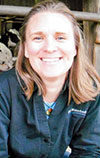You’ve done your research, and you are ready to make a change in your stalls. Maybe you’re changing from one mattress to another. Sand bedding to manure solids. Or maybe you’re switching from a deep bedding to dual waterbeds.
You’ve visited other farms. You’ve budgeted, planned your project and circled the day on the calendar. You are ready.
Another important question that is often overlooked is: How can you help your cows as they transition to new stalls?
Check your stall measurements
The week before the change, watch how your cows get up with the current bedding. Where is the level of the current bedding? Where will the new bed surface be? Do the cows hit the neck rail when they get up? Can they stand in the stall with all four feet in the stall? Where do the cows lunge? Will that change (or not) with the new bed surface? Where is the current brisket locator? Will that change (or not) after your change?
Answers to these questions are important to study and change at the same time as your bedding surface. You’re going to disrupt the cows with the stall surface change. If you need to move the stall, do it at the same time. It will be less of a headache for you and less disturbance for the cows. It may add a few dollars to the installation of a new bed, but it will reduce the stress on your cows (and you).
Checking the measurements of the stall (especially the neck rail) is critical if you are switching from a deep bedding to a mattress or waterbed.
The recommended placement of the neck rail on a deep-bedded stall is 6 inches closer to the curb than is recommended for a mattress or waterbed stall. Also, double-check the height from the base of the stall to the neck rail. With deep bedding, cows can dig out bedding to make enough room to get up. If you switch to mattresses or waterbeds, the cows will no longer be able to dig out the bedding. You may need to raise the neck rail to give them more room.
Get ‘their smell’ on any new material
Changing the bedding surface for a cow for the very first time is an adjustment. A new surface, a new smell and, possibly even, a new feeling. Adding a light dusting of manure can help the cows adapt by hiding the different smell.
What if she doesn’t adapt?
Sometimes there are one or two cows that resist change even more than we, as humans, do. Try placing the cow in a stall and preventing her from backing out for a short period of time until she lies down. Once she lies down on the surface, she will generally overcome her reluctance and use the stall at the next opportunity.
It is reasonable to expect cows to take a couple of weeks to adapt to stall changes. When steps are taken to help cows with the transition, producers should experience minimal health and production losses.
Change can be difficult
When you visit farms or after you’ve made your decision to switch, try calling a few farmers back who helped you make the decision and ask how their transition went. They may be able to give you some good advice on things they wished they’d done differently.
But, most of all, be patient with yourself and your cows. ![]()

-
Amy Throndsen
- Chief Operating Officer
- Advanced Comfort Technology
- Email Amy Throndsen
PHOTO: A tip for transitioning cows into new stalls or a new stall surface is to place the cow in a stall and prevent her from backing out for a short period of time until she lies down. This will help her overcome her reluctance to use the stall. Photo provided by Amy Throndsen.







